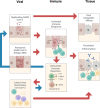Viral persistence, reactivation, and mechanisms of long COVID
- PMID: 37140960
- PMCID: PMC10159620
- DOI: 10.7554/eLife.86015
Viral persistence, reactivation, and mechanisms of long COVID
Abstract
The COVID-19 global pandemic caused by the severe acute respiratory syndrome coronavirus 2 (SARS-CoV-2) infection has infected hundreds of millions of individuals. Following COVID-19 infection, a subset can develop a wide range of chronic symptoms affecting diverse organ systems referred to as post-acute sequelae of SARS-CoV-2 infection (PASC), also known as long COVID. A National Institutes of Health-sponsored initiative, RECOVER: Researching COVID to Enhance Recovery, has sought to understand the basis of long COVID in a large cohort. Given the range of symptoms that occur in long COVID, the mechanisms that may underlie these diverse symptoms may also be diverse. In this review, we focus on the emerging literature supporting the role(s) that viral persistence or reactivation of viruses may play in PASC. Persistence of SARS-CoV-2 RNA or antigens is reported in some organs, yet the mechanism by which they do so and how they may be associated with pathogenic immune responses is unclear. Understanding the mechanisms of persistence of RNA, antigen or other reactivated viruses and how they may relate to specific inflammatory responses that drive symptoms of PASC may provide a rationale for treatment.
Keywords: PASC; Reactivation; SARS-CoV-2; epidemiology; global health; immunology; inflammation; long COVID; viral persistence.
Conflict of interest statement
BC, BJ, SM, SB No competing interests declared
Figures
Similar articles
-
Tissue injury and leukocyte changes in post-acute sequelae of SARS-CoV-2: review of 2833 post-acute patient outcomes per immune dysregulation and microbial translocation in long COVID.J Leukoc Biol. 2023 Mar 1;113(3):236-254. doi: 10.1093/jleuko/qiac001. J Leukoc Biol. 2023. PMID: 36807444 Review.
-
The Neurological Manifestations of Post-Acute Sequelae of SARS-CoV-2 infection.Curr Neurol Neurosci Rep. 2021 Jun 28;21(9):44. doi: 10.1007/s11910-021-01130-1. Curr Neurol Neurosci Rep. 2021. PMID: 34181102 Free PMC article. Review.
-
Therapeutic trials for long COVID-19: A call to action from the interventions taskforce of the RECOVER initiative.Front Immunol. 2023 Mar 9;14:1129459. doi: 10.3389/fimmu.2023.1129459. eCollection 2023. Front Immunol. 2023. PMID: 36969241 Free PMC article. Review.
-
Pathogenic mechanisms of post-acute sequelae of SARS-CoV-2 infection (PASC).Elife. 2023 Mar 22;12:e86002. doi: 10.7554/eLife.86002. Elife. 2023. PMID: 36947108 Free PMC article. Review.
-
SARS-CoV-2 reservoir in post-acute sequelae of COVID-19 (PASC).Nat Immunol. 2023 Oct;24(10):1616-1627. doi: 10.1038/s41590-023-01601-2. Epub 2023 Sep 4. Nat Immunol. 2023. PMID: 37667052 Review.
Cited by
-
Understanding autoimmune response after SARS-CoV-2 infection and the pathogenesis/mechanisms of long COVID.Med Rev (2021). 2024 May 27;4(5):367-383. doi: 10.1515/mr-2024-0013. eCollection 2024 Oct. Med Rev (2021). 2024. PMID: 39444797 Free PMC article. Review.
-
Interactions of SARS-CoV-2 with Human Target Cells-A Metabolic View.Int J Mol Sci. 2024 Sep 16;25(18):9977. doi: 10.3390/ijms25189977. Int J Mol Sci. 2024. PMID: 39337465 Free PMC article. Review.
-
Uncovering the Contrasts and Connections in PASC: Viral Load and Cytokine Signatures in Acute COVID-19 versus Post-Acute Sequelae of SARS-CoV-2 (PASC).Biomedicines. 2024 Aug 23;12(9):1941. doi: 10.3390/biomedicines12091941. Biomedicines. 2024. PMID: 39335455 Free PMC article. Review.
-
Long Neuro-COVID-19: Current Mechanistic Views and Therapeutic Perspectives.Biomolecules. 2024 Aug 28;14(9):1081. doi: 10.3390/biom14091081. Biomolecules. 2024. PMID: 39334847 Free PMC article. Review.
-
Exploring metabolic anomalies in COVID-19 and post-COVID-19: a machine learning approach with explainable artificial intelligence.Front Mol Biosci. 2024 Sep 9;11:1429281. doi: 10.3389/fmolb.2024.1429281. eCollection 2024. Front Mol Biosci. 2024. PMID: 39314212 Free PMC article.
References
-
- Aguilar-Bretones M, Westerhuis BM, Raadsen MP, de Bruin E, Chandler FD, Okba NM, Haagmans BL, Langerak T, Endeman H, van den Akker JP, Gommers DA, van Gorp EC, GeurtsvanKessel CH, de Vries RD, Fouchier RA, Rockx BH, Koopmans MP, van Nierop GP. Seasonal Coronavirus-specific B cells with limited SARS-Cov-2 cross-reactivity dominate the IgG response in severe COVID-19. The Journal of Clinical Investigation. 2021;131:e150613. doi: 10.1172/JCI150613. - DOI - PMC - PubMed
-
- Anand SP, Prévost J, Nayrac M, Beaudoin-Bussières G, Benlarbi M, Gasser R, Brassard N, Laumaea A, Gong SY, Bourassa C, Brunet-Ratnasingham E, Medjahed H, Gendron-Lepage G, Goyette G, Gokool L, Morrisseau C, Bégin P, Martel-Laferrière V, Tremblay C, Richard J, Bazin R, Duerr R, Kaufmann DE, Finzi A. Longitudinal analysis of humoral immunity against SARS-Cov-2 spike in Convalescent individuals up to 8 months post-symptom onset. Cell Reports. Medicine. 2021;2:100290. doi: 10.1016/j.xcrm.2021.100290. - DOI - PMC - PubMed
-
- Anderson EM, Goodwin EC, Verma A, Arevalo CP, Bolton MJ, Weirick ME, Gouma S, McAllister CM, Christensen SR, Weaver J, Hicks P, Manzoni TB, Oniyide O, Ramage H, Mathew D, Baxter AE, Oldridge DA, Greenplate AR, Wu JE, Alanio C, D’Andrea K, Kuthuru O, Dougherty J, Pattekar A, Kim J, Han N, Apostolidis SA, Huang AC, Vella LA, Kuri-Cervantes L, Pampena MB, Betts MR, Wherry EJ, Meyer NJ, Cherry S, Bates P, Rader DJ, Hensley SE, UPenn COVID Processing Unit Seasonal human Coronavirus antibodies are boosted upon SARS-Cov-2 infection but not associated with protection. Cell. 2021;184:1858–1864. doi: 10.1016/j.cell.2021.02.010. - DOI - PMC - PubMed
Publication types
MeSH terms
Substances
Grants and funding
LinkOut - more resources
Full Text Sources
Medical
Miscellaneous


